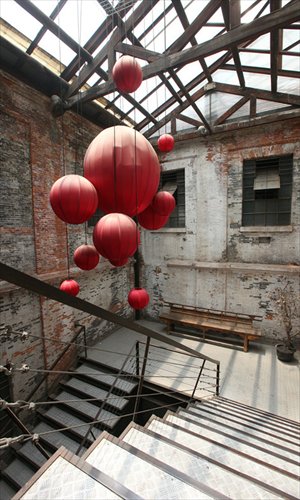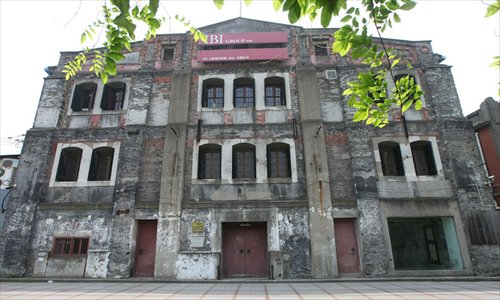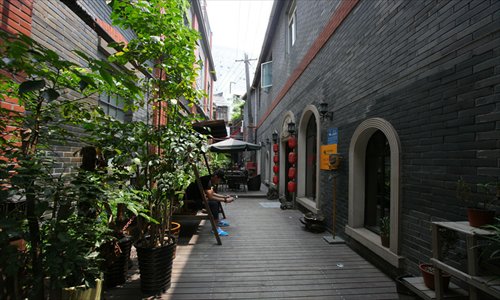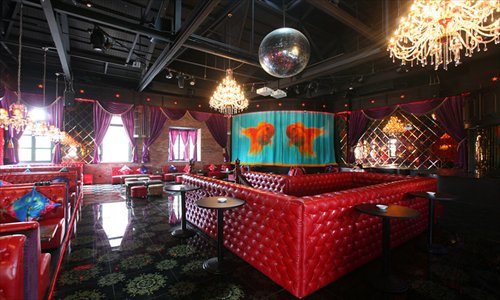Down by the riverbank




When the three written characters 苏州河 (suzhou he), first appear on screen in Lou Ye's 2000 film, Suzhou Creek, an unseen man's voice is heard shouting in the distance, hoarse, seemingly indifferent, but somewhat pained.
This dismembered voice might be the sound of the river itself; its past, present, and perhaps its future.
As Lou shows in the film, Suzhou Creek could be Shanghai's version of the Styx, the mythical waterway of the underworld along which the souls of the dead were ferried.
When walking along the riverbank of Nansuzhou Road, it's all too easy to forget the glitzy, modern face of Shanghai and to lose yourself in its lonely architecture of factory buildings and abandoned warehouses.
Virtually unchanged
In 1908, the Shanghai merchant/gangster Du Yuesheng set up a number of warehouses along Suzhou Creek, all of which were taken over by the State after the founding of the People's Republic of China in 1949. The building at No.1247 Nansuzhou Road is one such remaining example.
And today, under the name of River South Art Space (6359-8989), this former warehouse was transformed in 2003 by the Taiwanese actor and ballet dancer Steve Wang. The interior structure of the building has been preserved and is virtually unchanged.
Years of inclement weather have undoubtedly taken their toll on the window cases, and much of the steelwork has rusted which somehow seems fitting given that there is now an exhibition of stainless steel sculptures being held on the second floor. They are all the works of the Dutch artist, Ronald A. Westerhuis created during the past 12 years.
This artist describes stainless steel as "cold, hard and indestructible, but it is also vulnerable and sensitive and a medium that is full of character and inviting to the touch. I like its permanence and immutability," Westerhuis told the Global Times.
Although he has exhibited his stainless steel works in other Shanghai spaces, he prefers this venue. "Most of my creations look abstract, post-modern and 'Western,' which I think makes for an interesting contrast with the environment here, which is obsolete, 'Eastern' and with a heavy sense of history," Westerhuis said.
The exhibition will run until June 10 (except Monday, 1 pm to 8:30 pm).
At No.1295 is another warehouse, originally built in 1902. The red and green brick masonry of the external walls is today covered in a carpet-like moss.
When we rang the bell, a ghostly middle-aged male voice answered back, "no one here today."
The list of gold plates affixed near the door, however, revealed that several businesses now occupy the building.
At No.1307, a wooden block engraved with the four Chinese characters 苏州河畔 (suzhou hepan - the riverside of Suzhou Creek) hangs in the doorway, welcoming visitors to pass through the corridor behind it. And off this corridor, is a branch of Shanghai Soho International Hostel (5888-8817, www.yhaoline.com).
A stone archway leads into a courtyard with red lanterns hanging from the entrance, while inside the courtyard is a wooden rocking chair, a stone table and stools, flowerpots and bird cages. It is a popular place for young couples, both Chinese and foreigners.
This narrow building has a history of more than 150 years, and now is a place of respite for backpackers, featuring many free services including unblocked access to Facebook on the public computers. The hostel also has a small bar.
Chatting services
Wee Coffee (No.356 Xinzha Road, 3366-1355) located on the corner of Nansuzhou Road provides free "chatting services" for customers. According to shop manager, Shao Jianjian, the coffee bar was started by more than 60 people from all over the country, and overseas, who all met over the Internet.
Many of these shareholders are lawyers, financiers, advertising consultants and counselors by profession, and they decided to offer this unique chatting service to customers.
People can submit an application on the website (weecoffee356.com) in advance, and staff will arrange for them to chat with someone who suits their personal or professional needs.
At the section of Nansuzhou Road which borders the North Bund and Waibaidu Bridge stands a bar and café called Shanghai Rose (No.76, 6052-7171). This building was formally the Shanghai Rowing Club and boasts traditional architecture that features both Victorian and Edwardian Baroque styles.
However, the interior has acquired a completely new aspect, and is the creation of Ninagawa Mika, the Japanese photographer, film director and visionary artist. The colors are vibrant and bright with strong motifs of flowers and goldfish.